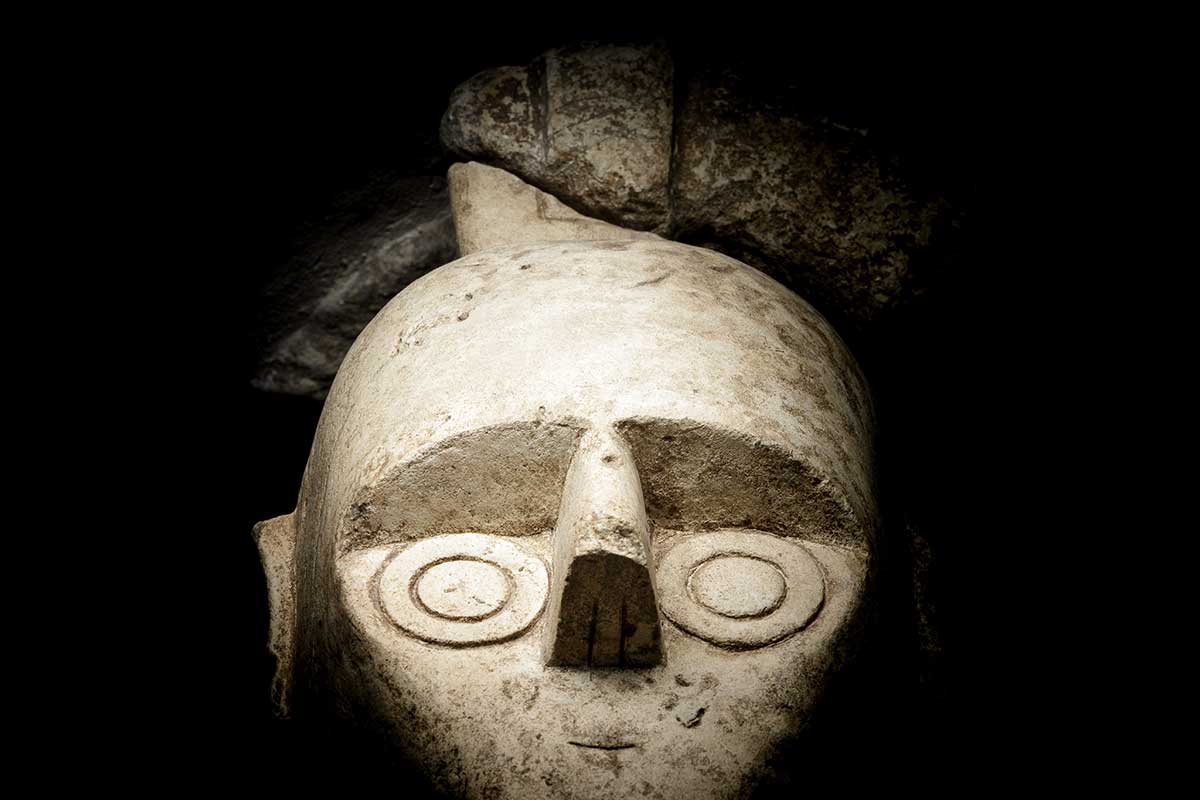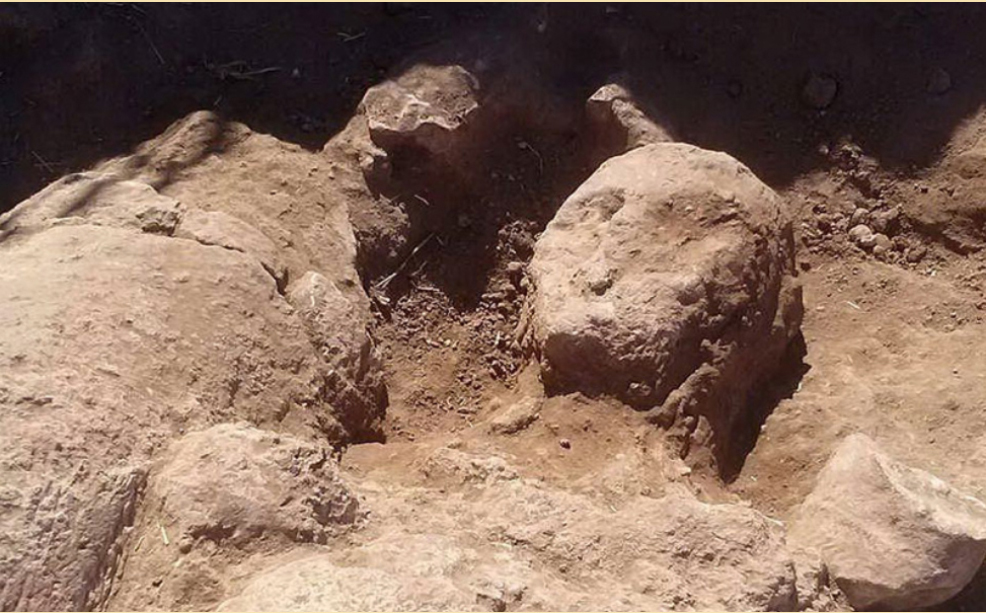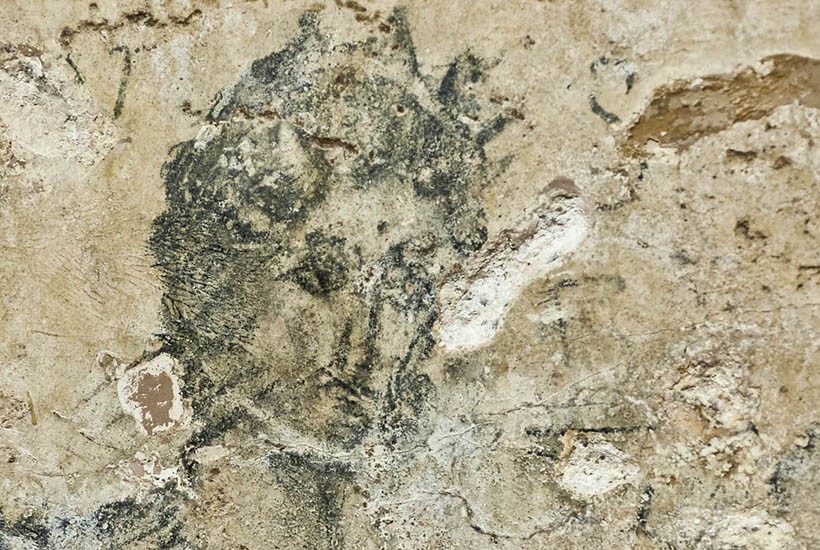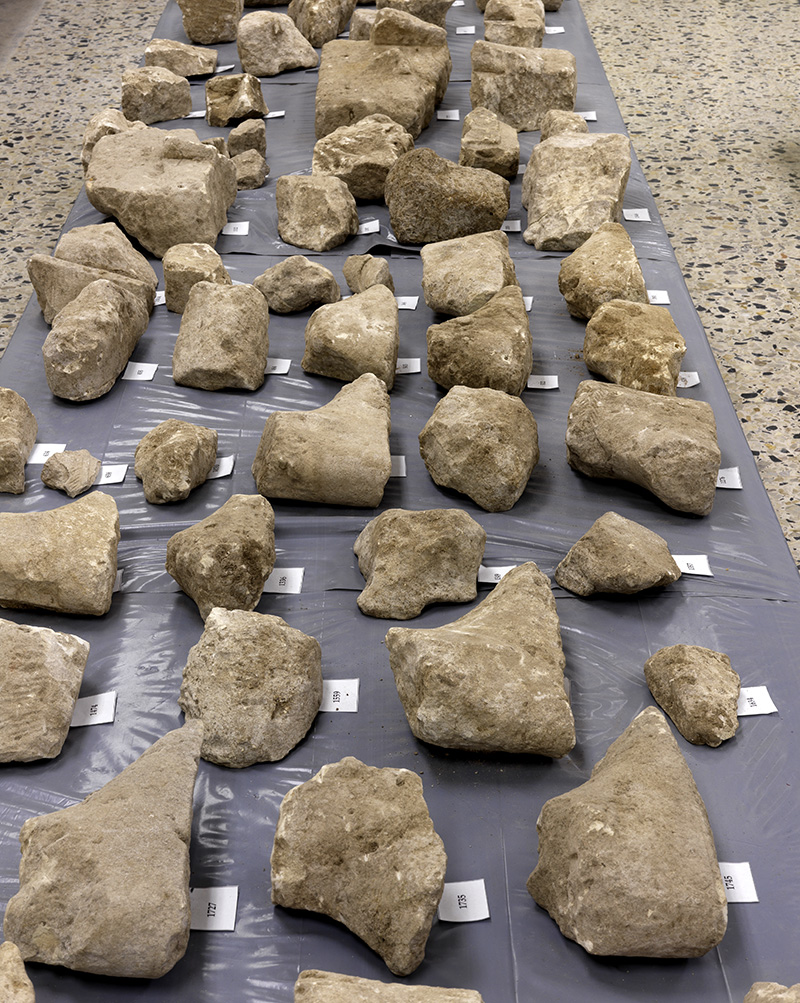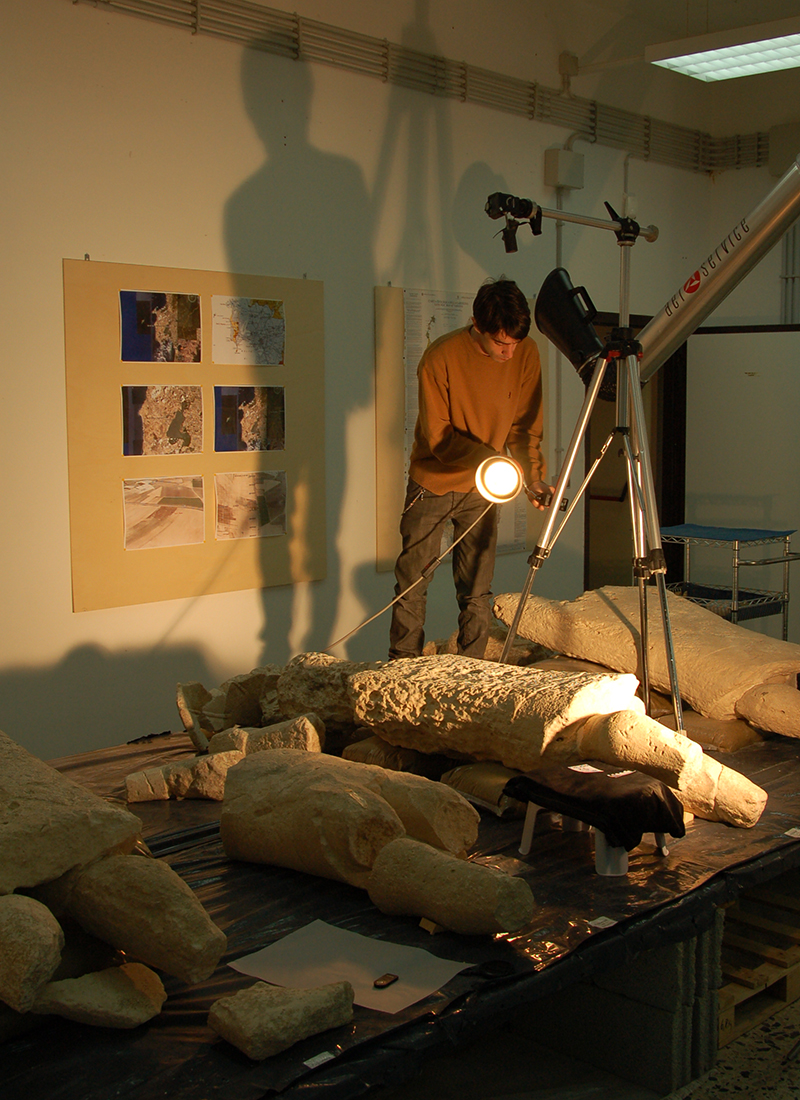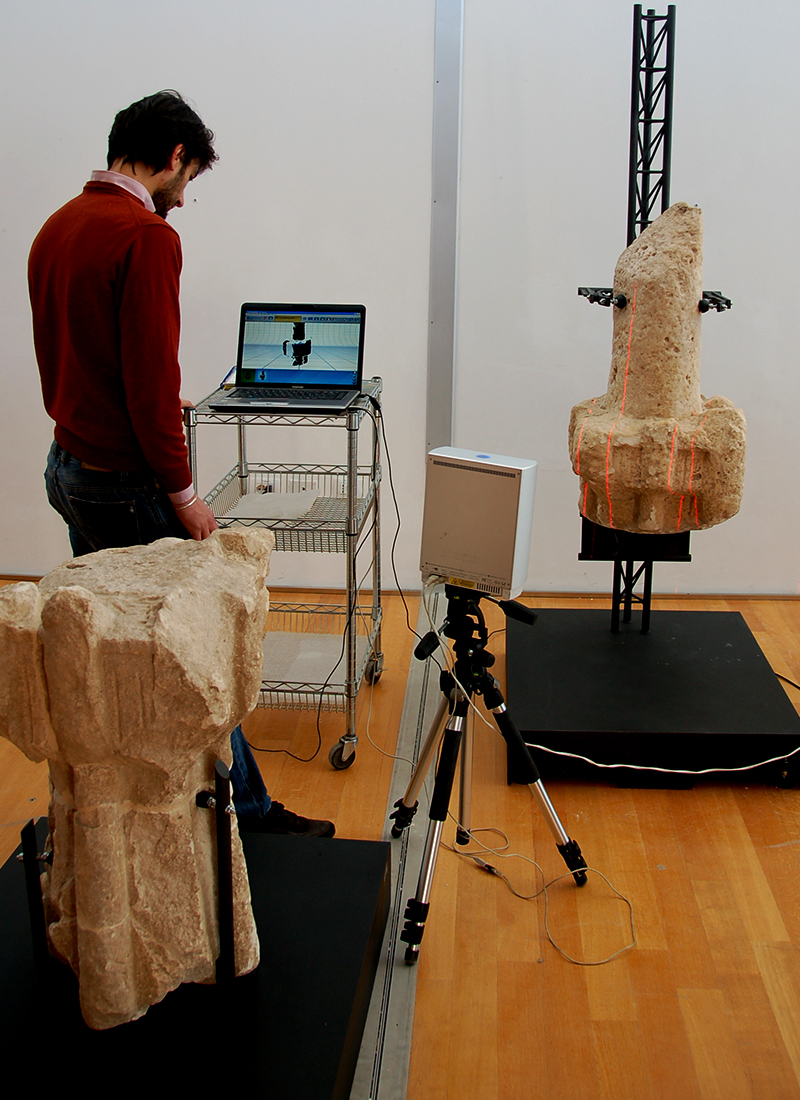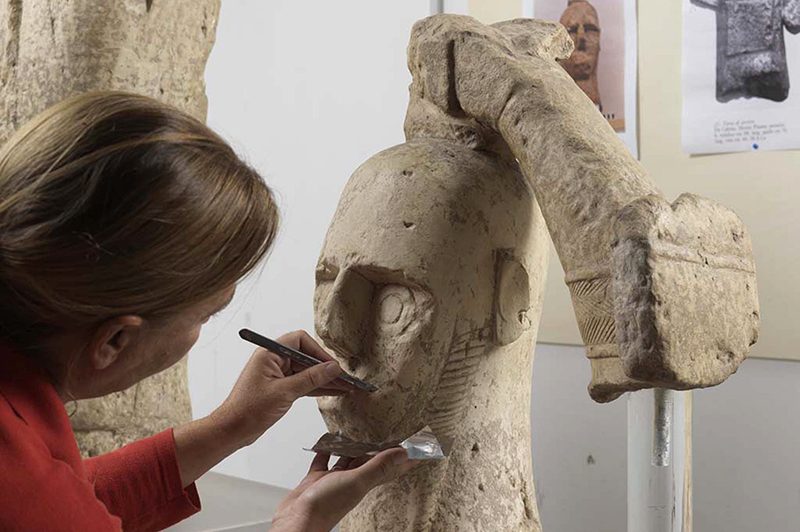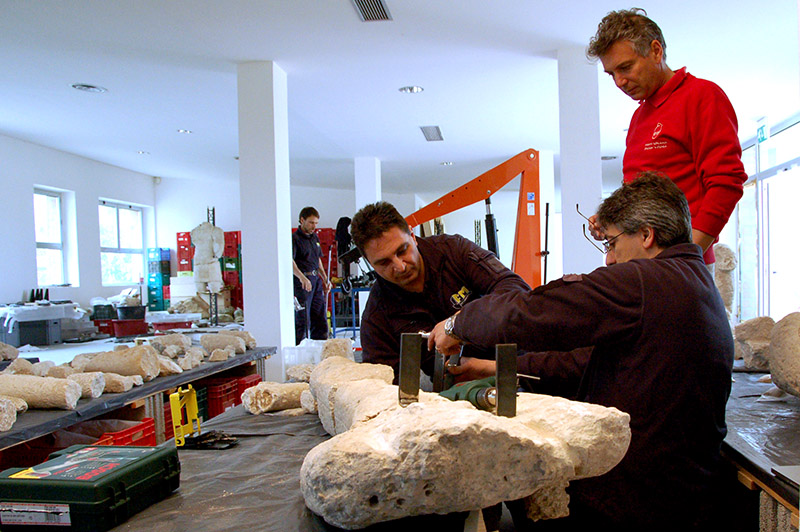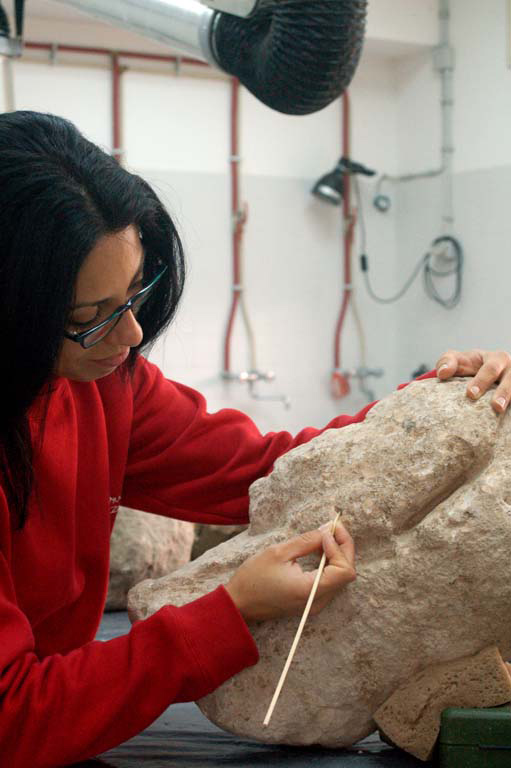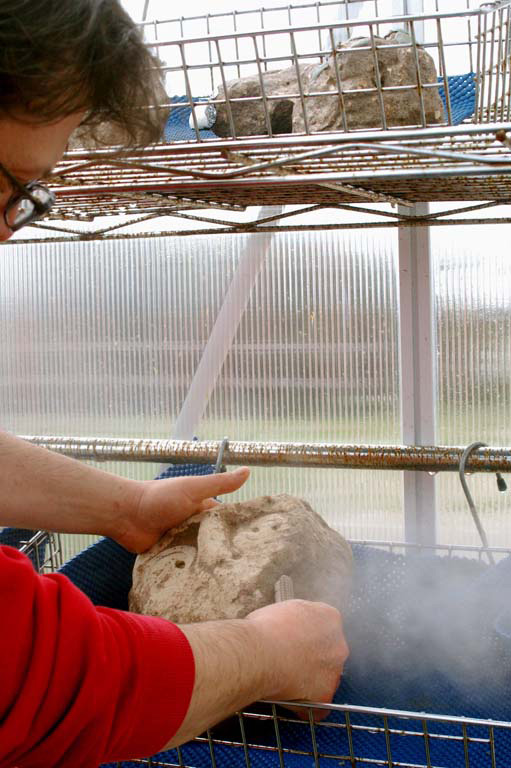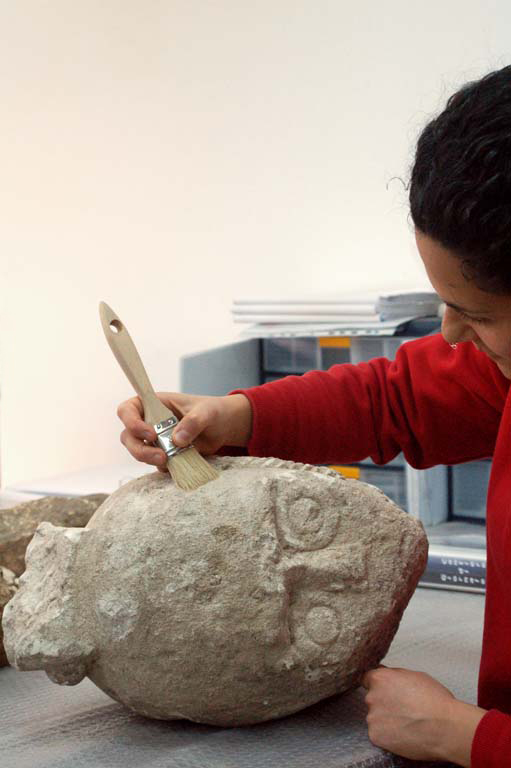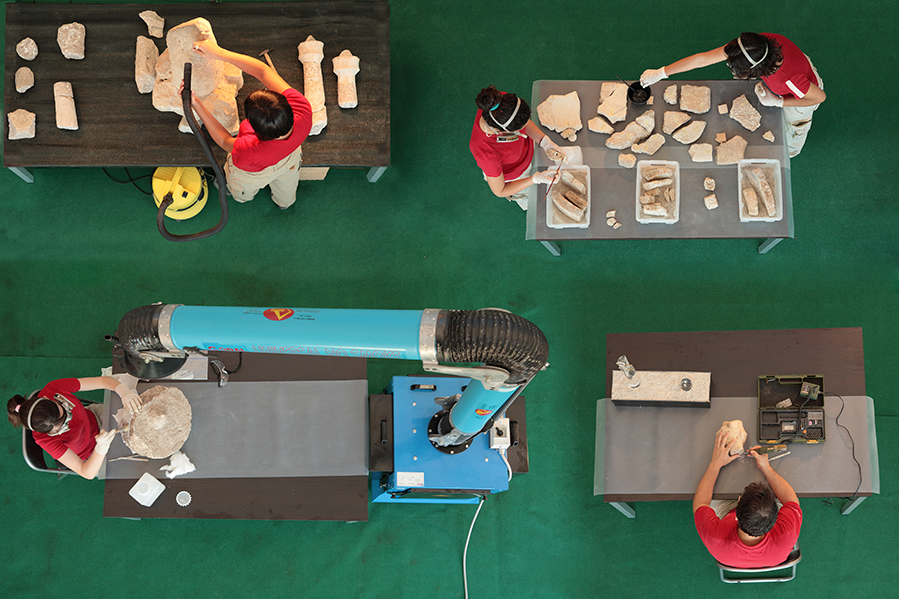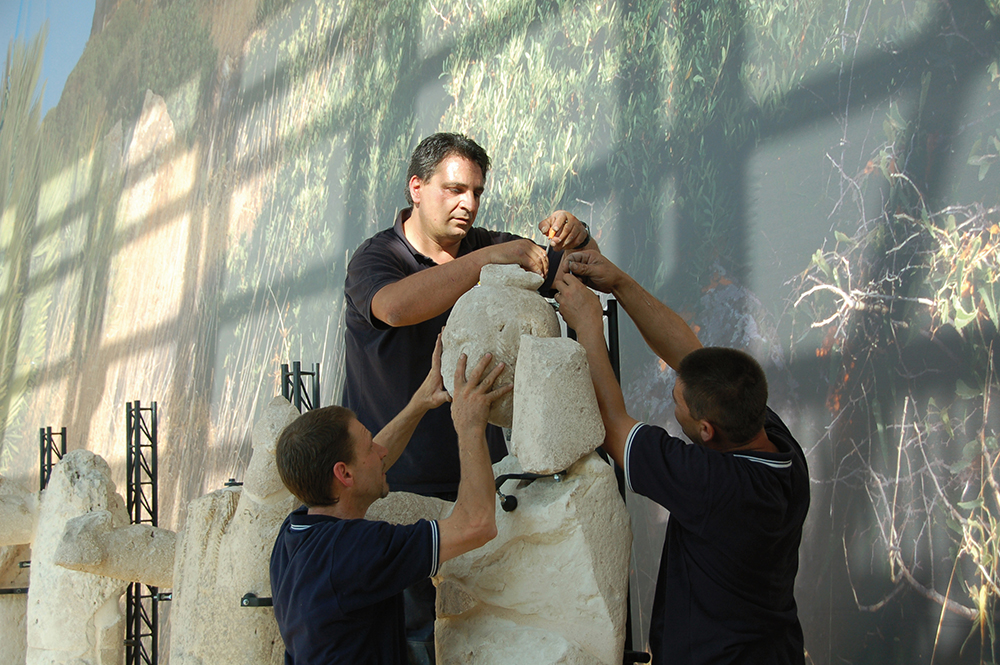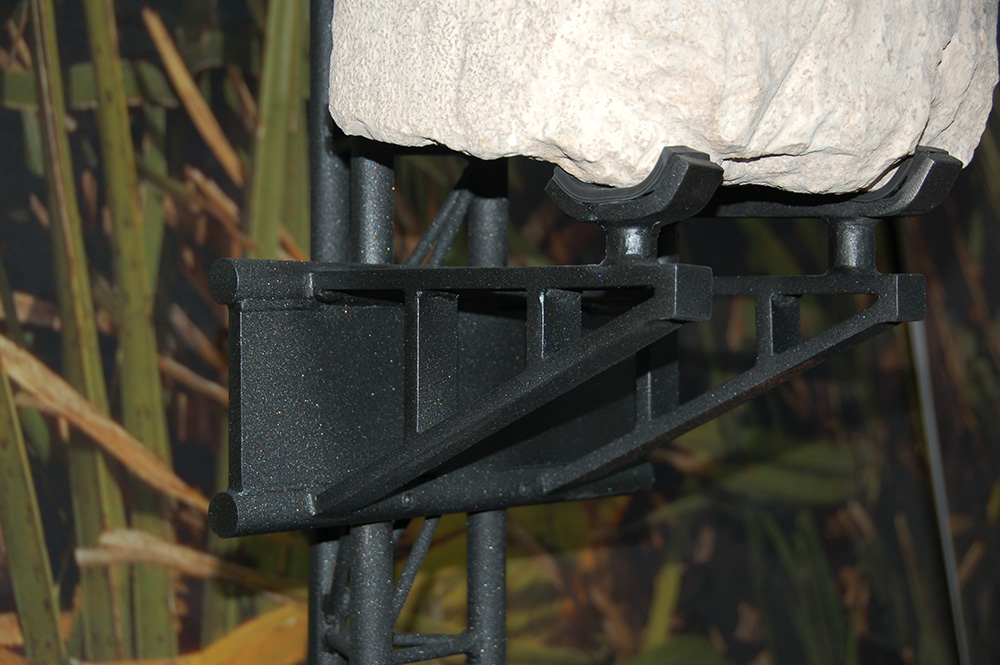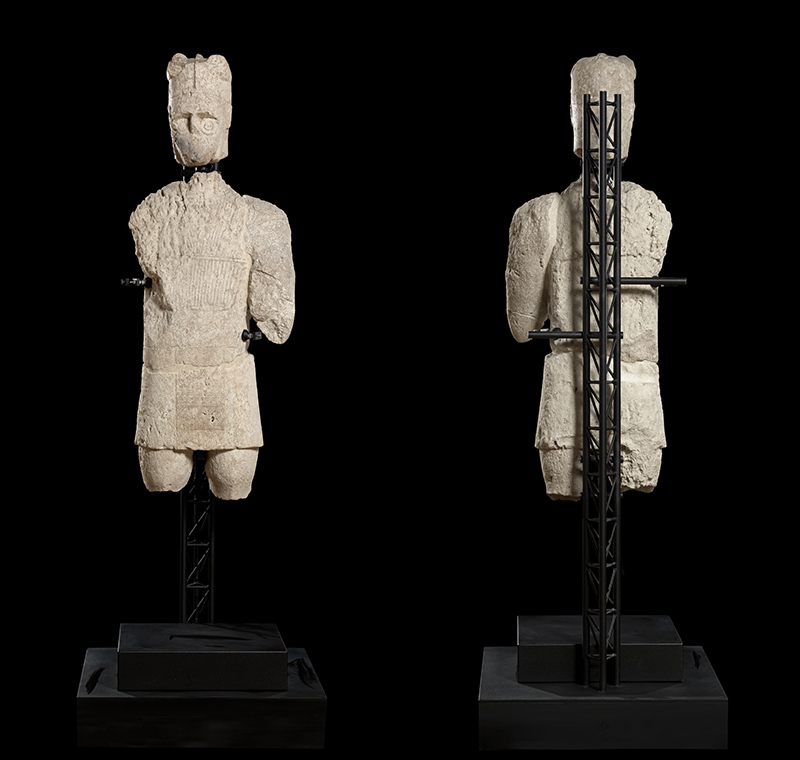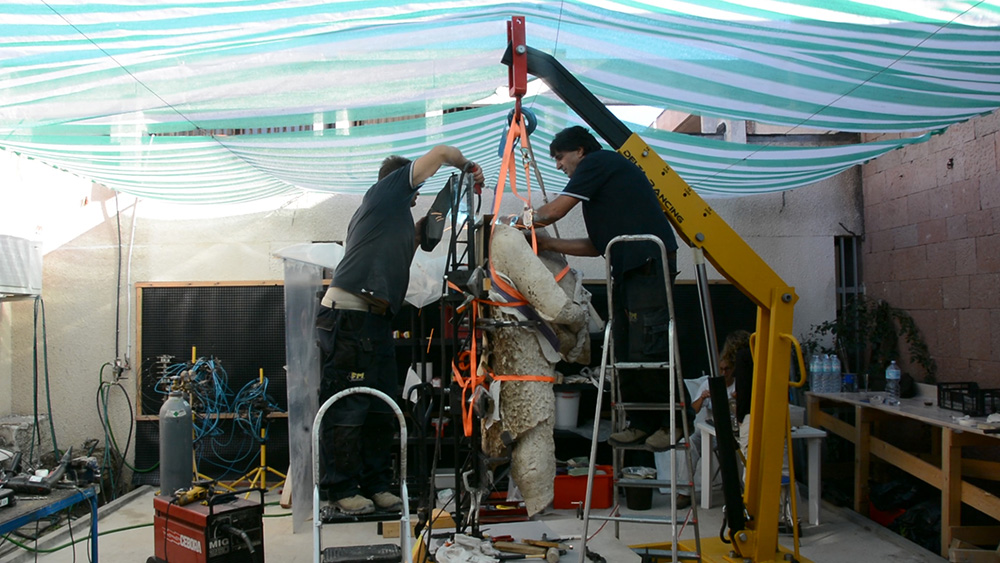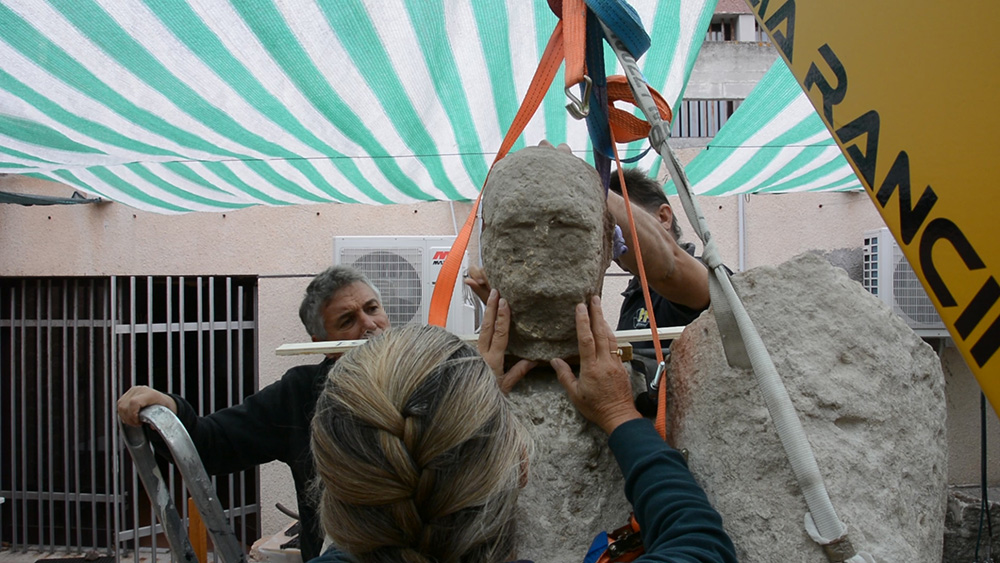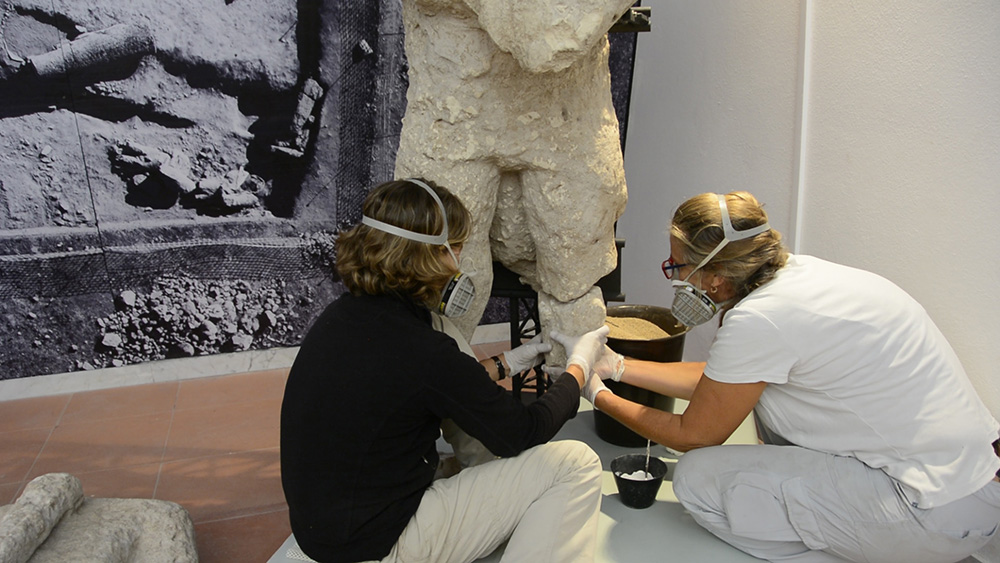The restoration
The excavation campaigns carried out since the 1970s in the archaeological site of Mont’e Prama have brought to light an immense and indefinite material number of fragments which continuously increases as excavations continue.
The number of restored sculptures is also growing continuously. So far, the restored sculptural heritage is impressive: 44 sculptures, including archers, warriors, boxers and models of nuraghes, plus numerous betyls.
The height of the statues varies from 185 to 200 cm. They rest on a 15 cm base to provide adequate support to the heavy, fragile block of stone.
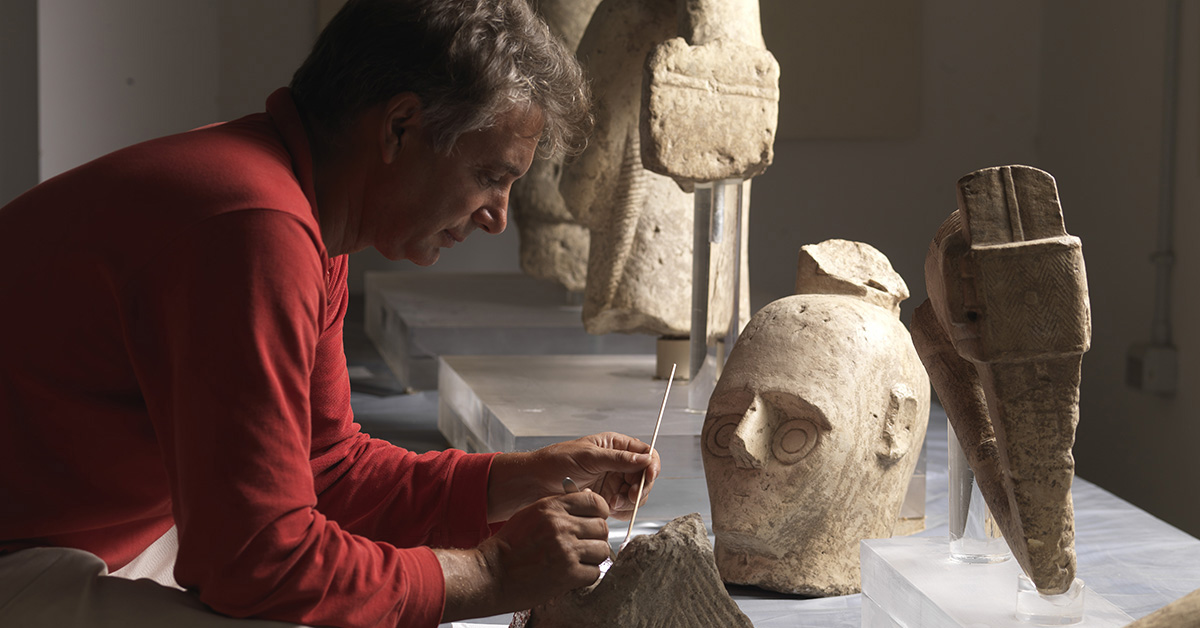
Over four hundred of these fragments were assembled in the first phase of restoration at the Li Punti Centre in Sassari where, in November 2011, the entire sculpture complex was displayed to the public for the first time since its discovery, in the temporary exhibition La pietra e gli eroi (The stone and the heroes).
Other fragments, attributable to the new finds discovered in the excavation campaigns of 2014 and 2015, were assembled in the site set up at the Civic museum ‘Giovanni Marongiu’ in Cabras.
This restoration project focused mainly on two models of 4-lobed nuraghes (another two are still to be restored), the statue of an archer and one of the two new types of boxer statues, similar to the Nuragic bronze statuette found in the Villanovan culture tomb of Cavalupo in Vulci (VT), with a great shield and armed glove held in front of the body instead of at head height. The second statue is on display but still requires restoration work.

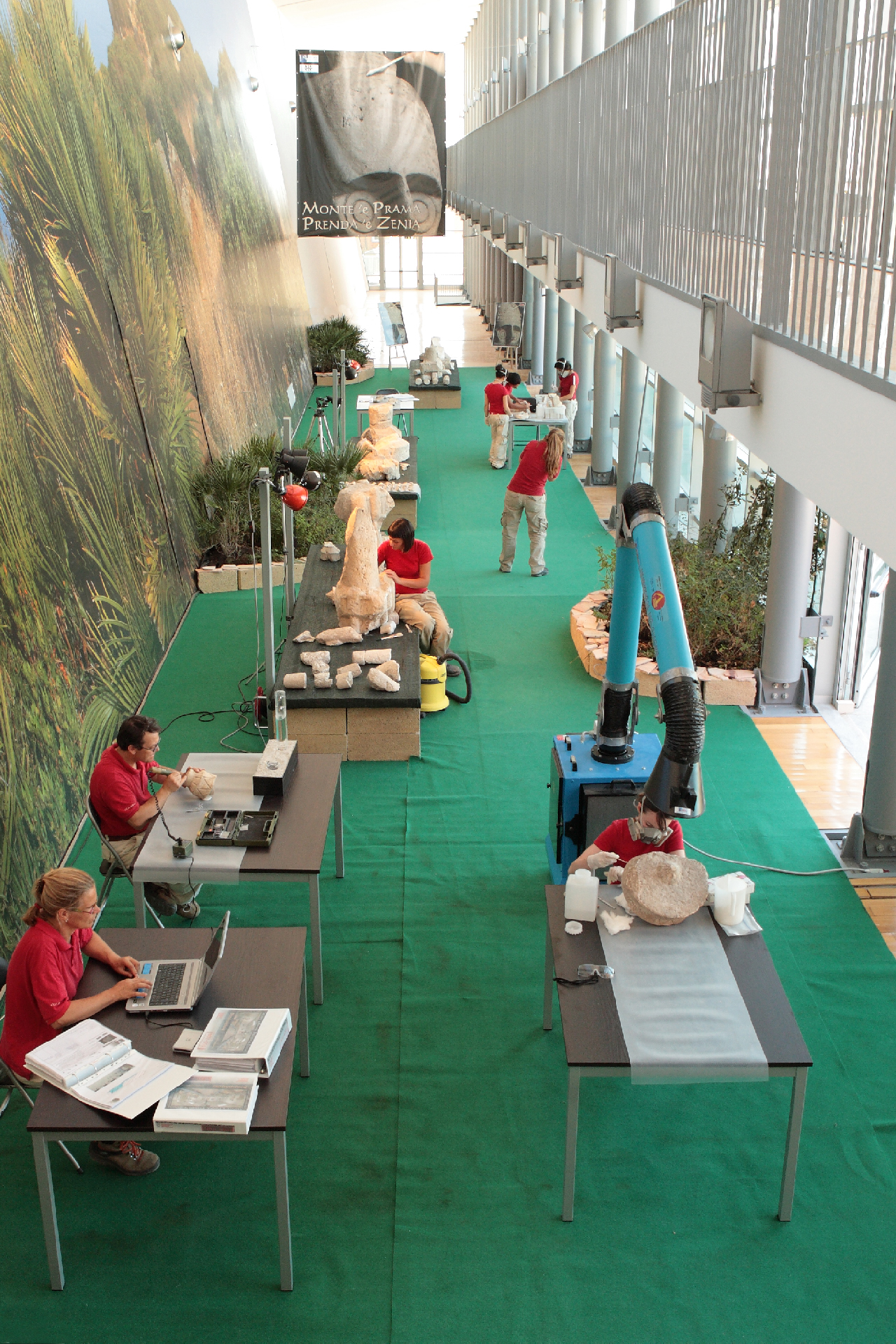
The restoration work
Until 2005, due to the lack of suitable premises, equipment, personnel and funding, the Archaeology Superintendency of Cagliari decided to put on hold systematic restoration of the sculptures and limited works to preliminary restoration of some important fragments, on show in the Cagliari National archaeological museum from 1977.
Restoration of the Mont’e Prama sculptures was funded under the 2005 Framework Programme Agreement between the national and regional authorities, via project ‘SarBC3-18-Cultural Heritage Conservation Centre. Workshops open to the public’. These funds covered drafting of a preliminary project. This agreement was supplemented in 2007 by additional funding. Following a call for tenders, the contract was awarded to the Centro di Conservazione Archeologica (Archaeological Conservation Centre – ACC) of Roberto Nardi (Rome). The contractor drafted the definitive executive project, entitled ‘Prenda ‘e Zenia’ (‘Jewel of the Lineage’) which was implemented from 2007 to 2011.
The project had a total budget of EUR 1,600,000. The entire administrative and technical procedure was supervised by the Archaeology Superintendency of Sassari, in particular by Antonietta Boninu, Luisanna Usai, Alba Canu and Gonaria Demontis.
From November 2007 to November 2011 the “ACC” (Archaeological Conservation Centre) worked in the restoration workshops of Li Punti on the material found during the various excavation campaigns at the site between 1975 and 1979, which consisted of some 5,200 stone fragments, equivalent to an area of approximately 450 m2 and weighing more than 10 tonnes. The sizes of the individual fragments ranged from a few millimetres to dozens of centimetres.
Documentation
As they proceeded with restoration works, the experts documented the process, carefully recording all the data gathered during observation and analysis of the sculptures.
Data collection was performed through archiving, managed by a database with a data sheet on each fragment and each sculpture, listing:
- Data on excavation and restoration
- Photo evidence gathered before, during and after restoration
- Drawings
- Video documentation
- 3D views acquired by laser scanner for rendering of the sculptures, virtual restoration and the possible creation of copies.
Diagnostic analyses
Diagnostic analysis was performed before restoration, to identify the type of stone and its alterations and transformations. Examination with optic microscope, petrographic microscope and SEM-EDS, (Scanning Electron Microscopy with Energy Dispersive Spectroscopy) showed that the stone used for the sculptures was sedimentary organic limestone, rich in fossils.
Some fragments bore slight traces of red or black colouring.
Direct analysis of the surfaces allowed the collection of data and information on stone working techniques, tools and methodology. Lastly, the state of conservation was analysed. This is a key step before any restoration project, and serves to identify the various degradation processes.
After obtaining a better overall picture of the context and characteristics of each fragment, and after completing analysis and data acquisition, the actual restoration work could start.
While the latest technologies were used for the recording, study and analysis of the original material and for disseminating results of the work done, the restoration itself was based on simple, traditional techniques for restoration, to best maintain the original materials and ancient surfaces.
Cleaning
The first phase was cleaning: this is an irreversible operation which must be performed in a sequence of steps, mainly using mechanical equipment, using atomized water which dissolves the dirt deposits, by means of a light aerosol of water and air, scrapers and blow cleaning. The aim of cleaning is to reveal fully the surfaces and to remove damaging substances. In portions of crumbling stone, cleaning is preceded by local protection and strengthening, to ensure that the action of the atomization aerosol would not damage the original surface. Next, consolidation is performed as needed, for example on fragile, badly degraded or joint surfaces. Consolidation is performed using inorganic materials such as limewater and ethyl silicate, to protect the original surfaces and prepare the fragments for gluing.
The search of binding points
The second phase focused on identifying the attachment points of the various fragments. This is a very long and complex process, performed manually by the restorers, who relied on their experience to recognise the many small clues found on the original surfaces, including visual and tactile details, to assign each fragment to a specific sculpture or to join fragments with each other.
Given the abraded state of the break points of the fragments and the great variety of surface types, digital technology was not helpful in recognition. The expert eye of the professional restorer was the only way to detect differences and similarities.
In the case of the sculptures of Mont’e Prama, the painstaking process of piecing together the sculpture lasted two years. A key element of its success was the familiarity gradually built by the restorers – always the same – with the materials they were handling.
Assembling the pieces, adding plaster and filling the gaps
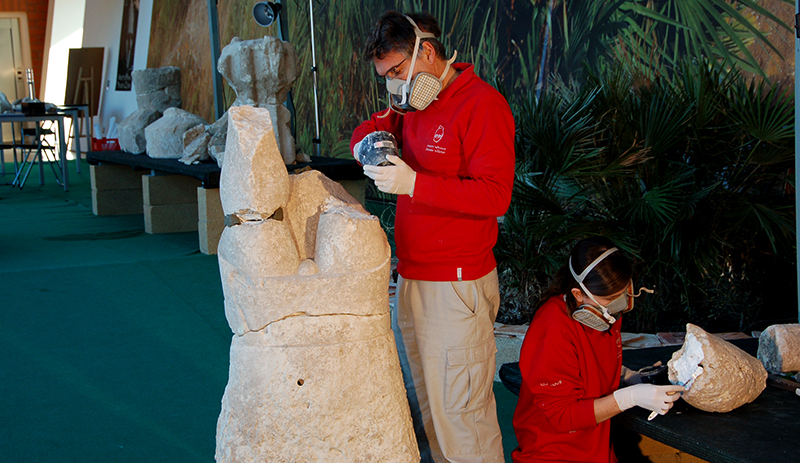
The next step was assembling the pieces, adding plaster and filling the gaps. Since the guiding principle was to respect fully the ancient materials, no holes were bored and no pins were used to assemble the sculptures. Matching fragments were assembled only by means of synthetic resins. External metal elements were used only as static supports for the reassembled sculptures. To glue the pieces, two techniques were used at the same time: a light acrylic resin film with reversible properties was applied to the contact surfaces, and a strongly bonding two-part epoxy adhesive was applied for structural purposes. Lastly, the cracks and break lines of the various fragments were filled with lime-based mortar to improve the aesthetic effect of the surfaces and prevent the build-up of dust.
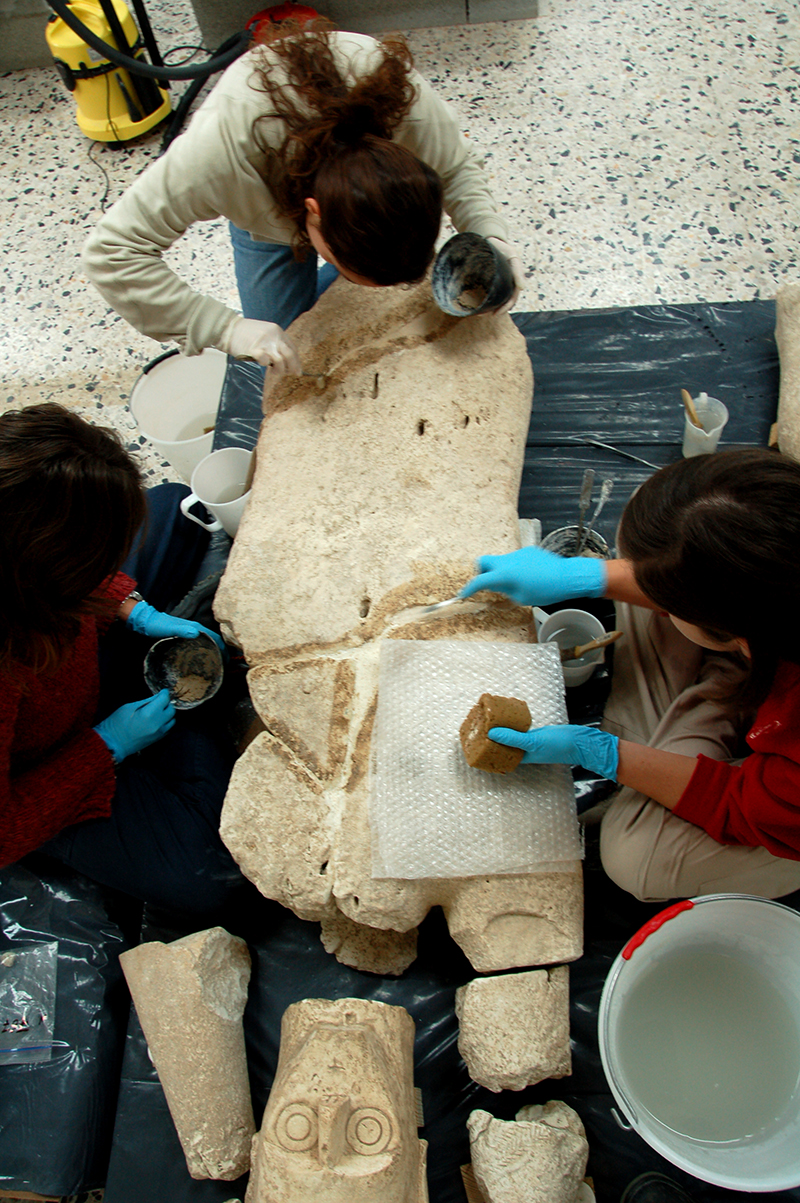
The latticed metal support
To ensure conservation, each restoration action must respect the rules of compatibility (with original materials) and reversibility.
Lastly, to put the statues on display, metal supports were needed since, even after the fragments were assembled, the statues could not stand on their original base.
Thus, trellised columns were designed and made: they allow the statues to stand and to be viewed from all sides. These steel supports consist of a central latticed column, from which arms extend, supporting the various pieces of the sculptures.
These supports were designed specifically to preserve the integrity of the original stone (without using pins) and to meet requirements of stability, minimum deformability, least visibility of the metal structure, possibility of later additions and total reversibility of the parts.
The restoration centre at Cabras
In June 2015 and 2016, under the supervision of the Archaeological Superintendency of Cagliari, as part of a teaching programme organised by the Archaeological Conservation Centre in collaboration with several US universities, the ACC started to restore the sculptures found during the excavation campaigns of 2014 and 2015, setting up a site at the Giovanni Marongiu museum in Cabras.
The same approach tested successfully in the previous round of restoration was followed: cleaning and preliminary treatment of all the sculpture fragments, piecing them together and mounting of selected sculptures on metal supports.
This time, the work focused on two models of four-lobed nuraghes (while two more still await restoration), the statue of an archer and the statue of a boxer of new type. This newly discovered figure is similar to the statuette found in a grave of the Villanovan culture at Cavalupo in Vulci (VT): the figure is holding a large shield and wearing an armed glove, both stretched out in front of the body instead of held at head height. A second similar statue has still to be restored.



